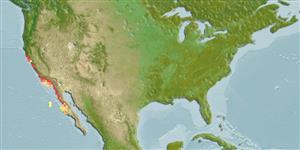>
Blenniiformes (Blennies) >
Chaenopsidae (Pike-, tube- and flagblennies)
Etymology: Neoclinus: Greek,neos = new + Greek, klinein, kline = sloping and bed, due to the four apophyses of sphenoid bone (Ref. 45335); uninotatus: Neoclinus new Clinus ; uninotatus one mark, for the single ocellatus (Ref. 4930).
Environment: milieu / climate zone / depth range / distribution range
Écologie
marin démersal; profondeur 3 - 27 m (Ref. 2850). Subtropical; 39°N - 27°N, 124°W - 114°W
Eastern Pacific: Bodega Bay in northern California, USA to northern Baja California, Mexico.
Length at first maturity / Taille / Poids / Âge
Maturity: Lm 8.9 range ? - ? cm
Max length : 25.0 cm TL mâle / non sexé; (Ref. 2850); âge max. reporté: 7 années (Ref. 43439)
Usually occurs on bottom along coast and in bays. Lives inside objects, including bottles, cans, and tires.
Females lay eggs in abandoned boring clam holes, under rocks, in beer containers, and other containers. Males guard the eggs until they hatch (Ref. 43439).
Eschmeyer, W.N., E.S. Herald and H. Hammann, 1983. A field guide to Pacific coast fishes of North America. Boston (MA, USA): Houghton Mifflin Company. xii+336 p. (Ref. 2850)
Statut dans la liste rouge de l'IUCN (Ref. 130435: Version 2024-1)
Menace pour l'homme
Harmless
Utilisations par l'homme
Outils
Articles particuliers
Télécharger en XML
Sources Internet
Estimates based on models
Preferred temperature (Ref.
123201): 12.8 - 19, mean 15.9 °C (based on 43 cells).
Phylogenetic diversity index (Ref.
82804): PD
50 = 0.5005 [Uniqueness, from 0.5 = low to 2.0 = high].
Bayesian length-weight: a=0.00525 (0.00219 - 0.01260), b=3.06 (2.85 - 3.27), in cm total length, based on LWR estimates for this (Sub)family-body shape (Ref.
93245).
Niveau trophique (Ref.
69278): 3.5 ±0.50 se; based on food items.
Résilience (Ref.
120179): Milieu, temps minimum de doublement de population : 1,4 à 4,4 années (tm=1; tmax=7; Fec = 600).
Fishing Vulnerability (Ref.
59153): Low vulnerability (15 of 100).
